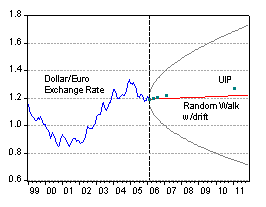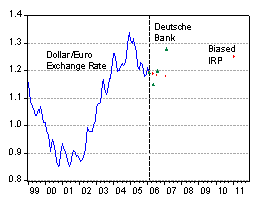Judgment, theory and correlations in exchange rate modeling.
Where is the dollar/euro exchange rate going? Given uncertainty over the proper model governing the world economy, I thought it might be interesting to compare what different approaches implied. In the first figure are the predictions from a purely statistical model, where it is assumed that the log exchange follows a random walk with drift. In this case the estimated drift is about +0.4% per annum (red line, labelled “Random walk with drift”). The plus/minus 2 standard errors bands are very large, which is not surprising given the imprecision of the point estimate.

Predictions of the dollar/euro exchange rate based on random walk model and uncovered interest parity. Source: Author’s calculations.
Since pure time-series approaches are relatively uninformative, it might be useful to appeal to theory. One of the building blocks of international finance is uncovered interest parity (UIP), which states the expected returns in common currency terms are equalized, or alternatively expected depreciation equals the interest differential. UIP implies depreciation as well (green squares, labelled “UIP”), both over the short and long term. At the 5 year horizon, depreciation of 1.3% is implied by bond yields with 5 years remaining to redemption.
Since ex post uncovered interest parity (average actual depreciation equals interest differentials) doesn’t hold statistically, it is of interest to consider what the empirical correlations imply. Using estimates reported in Chinn (2005), I show what current interest differentials indicate the exchange rate will be in the future (keeping in mind the low R-squared of the regressions that underly these calculations). This prediction is in red, labelled “Biased IRP”. At horizons up to a year, slight appreciation is implied (consistent with the view that higher interest rates in the US relative to Europe will induce a strengthening dollar). But over the longer horizon, it will depreciate. In contrast, subjective forecasts from Deutsche Bank indicate appreciation 3 months hence, but fairly rapid depreciation thereafter (green triangles). The JP Morgan forecasts are not substantially different (see Economist’s survey).

Interest rate implied changes and Deutsche Bank forecasts. Source: Author’s calculations and Deutsche Bank February Exchange Rate Perspectives
Technorati Tags: exchange rate,
euro,
uncovered interest parity,
random walk
What Time-Series aproaches are there, and why are they uninformative?
To make comparison with TS model fare and to support the claim that theoretical approach more informative it would be good to look at plus/minus 2 standard errors bands for theoretical models.
It isn’t just JP and Deutsche expecting USD depreciation beyond 3months. Looking at 12m analyst forecasts, there is a massive skew of opinion favouring a weaker USD. See the FX Week table:
(http://db.riskwaters.com/global/fxweek/fxforecast/130306_forecast.pdf).
If it is the street as a whole sharing this view, and not just bank analysts, this could perhaps be used as a contrarian indicator. That said, I am coming around to the view that there is more scope for higher rates from the ECB than the Fed in the medium-term, and while the USD may enjoy an absolute interest rate advantage, I would expect the narrowing of the rate differential at the front end of the curve to weigh on the USD. A turnaround in the cyclical story from USD-postitive to USD-negative, along with a clearly USD negative structural backdrop, could be very positive for EUR/USD. After all that, let me confess that I don’t have a position as my conviction is low.
On another note, I wonder where a basic PPP model puts EUR/USD right now?
For ppp chart see: http://fx.sauder.ubc.ca/PPP.html
Given this chart, why should the dollar decline vs. european currencies. I would think PPP would be tugging the dollar up vs euro etc. Where can I buy a zloty?
We know that the dollar will fall in value. The only question is when this virtually worthless currency will drop. Just today, the TICS data indicated for the second month in a row that inflows failed to cover the trade deficit.
It’s also likely that the Fed will stop tightening by Q3 at the very latest. So, if inflows continue to come up short, and the rate hike cycle comes to an end, the dollar should take a damn good beating. I’m sure the big FIs have already made good money going long on the dollar in the face of skull-crushing current account deficits, but they can only “game the system” so much until cold, hard economic reality sets in.
We know that the dollar will fall in value. The only question is when this virtually worthless currency will drop. Just today, the TICS data indicated for the second month in a row that inflows failed to cover the trade deficit.
It’s also likely that the Fed will stop tightening by Q3 at the very latest. So, if inflows continue to come up short, and the rate hike cycle comes to an end, the dollar should take a damn good beating. I’m sure the big FIs have already made good money going long on the dollar in the face of skull-crushing current account deficits, but they can only “game the system” so much until cold, hard economic reality sets in.
Emmanuel
Read carefully: ” The trade deficit could be ruinoius; it may ultimately lead to a deep recession with a sharply lower dollar and higher inflation”.
I believe the article title above echoes your general sentiment. But, alas, it was not written yesterday with the CA data release but 21 years ago!!! published May 8 1985 in Fortune and written by Fred – the dollar is always overvalued – Bergsten, first and so far only Director of The Institute for International Economics.
Marcus, I discovered a similarly USD bearish article in the Economist from 1997. That said, I am slowly starting to turn in to a USD bear, but only because I expect the cyclical support of expected interest rate differentials to recede over time, and in this situation the structural negatives could leave the USD exposed. Still, its only a marginal view.
Those thinking along the more extreme lines of Fortune and Economist articles, and Emmanuel’s comment, are not without substance, and while I think the chance of a USD collapse is minute, I think the risks would favour a sudden USD depreciation over a sudden USD appreciation. I wonder if the option market has priced in this assymmetric risk at the extremes.
My speculations will be the end of me!
Dollar future?
I really appreciated Menzie Chinn’s presentation (and fredw’s) at econbrowser on the theories behind future dollar predictions; it’s a fascinating subject, very relevant to what will happen to the US, and I picked up a couple of concepts. Thanks Menzie.
the historical event yr teacher did not teach you
: NEW YORK, March 15 (Reuters) – The dollar weakened on Wednesday after a Treasury Department report showed that net capital inflows into the United States in January failed to cover that month’s record trade deficit.
Now I would like u to read this historical event yr teacher did not teach you, u will be surprise to find out as yr terror is synthetic yr financial crises and economy is synthetic too, please lear from the History
I found this story amasing, it worth reading and hopefully should be circulated to the max. The world should not live in the 21st century with monetised money
Read this amazing historical story your teachers never taught you….
(Much of the following historical material is taken from a radio address given a half century ago by the late Congressman Charles G. Binderup, of Nebraska, and compiled by Mrs. Lucie Boulrice, 1133 Liberty, Springfield, MA 01104. For more information, you may write or call her at (413) 737-3080.
How America created its own money in 1750
Benjamin Franklin tells what made New England prosperous
____________________________
Colonies were more prosperous than the home country
Before the Declaration of Independence (1776) and the war that followed, the colonized part of what is today the United States of America was a Crown possession of England. It was called New England, and was made up of 13 colonies, which became the original states of the great Republic.
In 1750, this New England was very prosperous. Benjamin Franklin wrote: “There was abundance in the Colonies, and peace reigned on every border. It was difficult, even impossible, to find a happier and more prosperous nation on all the surface of the globe. Comfort prevailed in every home. The people, in general, kept the highest moral standards, and education was widely spread.”
When Franklin went over to England to represent the interests of the Colonies, he saw a completely different situation; the working population of the home country was gnawed by hunger and plagued by inescapable poverty. “The streets are covered with beggars and tramps,” he wrote. He asked his English friends how England, with all its wealth, could have so much poverty among its working classes. His friends replied that England was prey to a terrible condition; it had too many workers! The rich said they were already overburdened with taxes, and could not pay more to relieve the needs and poverty of this great mass of workers. Several rich Englishmen of that time actually believed what economist Thomas Malthus later wrote, that wars and epidemic disease were necessary to rid the country from “manpower surpluses.”
[edited by JDH for length]
The dollar will weaken when the “trading partners” stop printing and floating their own paper and the US consumer and government stops borrowing so much.
JPN has a zero interest rate policy and has been printing a trillion $ worth of YEN. Why would any one invest in the YEN when they could get dollars, with a real interest rate and currency appreciation ?
The Chinese, and other Asian nations, maintain dollar parity by printing an excess of their currencies and buying up dollars. It is no accident that the dollar remains relatively strong vis a vis the worlds other currencies. It is by design.
The random walk assumes that the relative value of the currencies fluctuate, well, randomly. Currency manipulation is not a random process so I am not surprised at the outcome.
Interest rate parity has a logical appeal, no doubt, especially when the higher rate can be obtained from the “reserve currency”. I think their is probably a “flight to quality” factor also at play whereby foreign investors are not as certain as we that the dollar will be the currency that collapses when the stuff hits the fan.
Most of the trade/currency models are based on the concept of nations trading goods and services. It seems to me that our trading partners will not buy American goods and services in sufficient quantities as a competitive strategy. The point is too “sell” to the US, not buy from us.
They even lend us the money to do it. You know, no payment till January and zero interest for five years.
I’ll be, I didn’t know anybody read The Economist anymore.